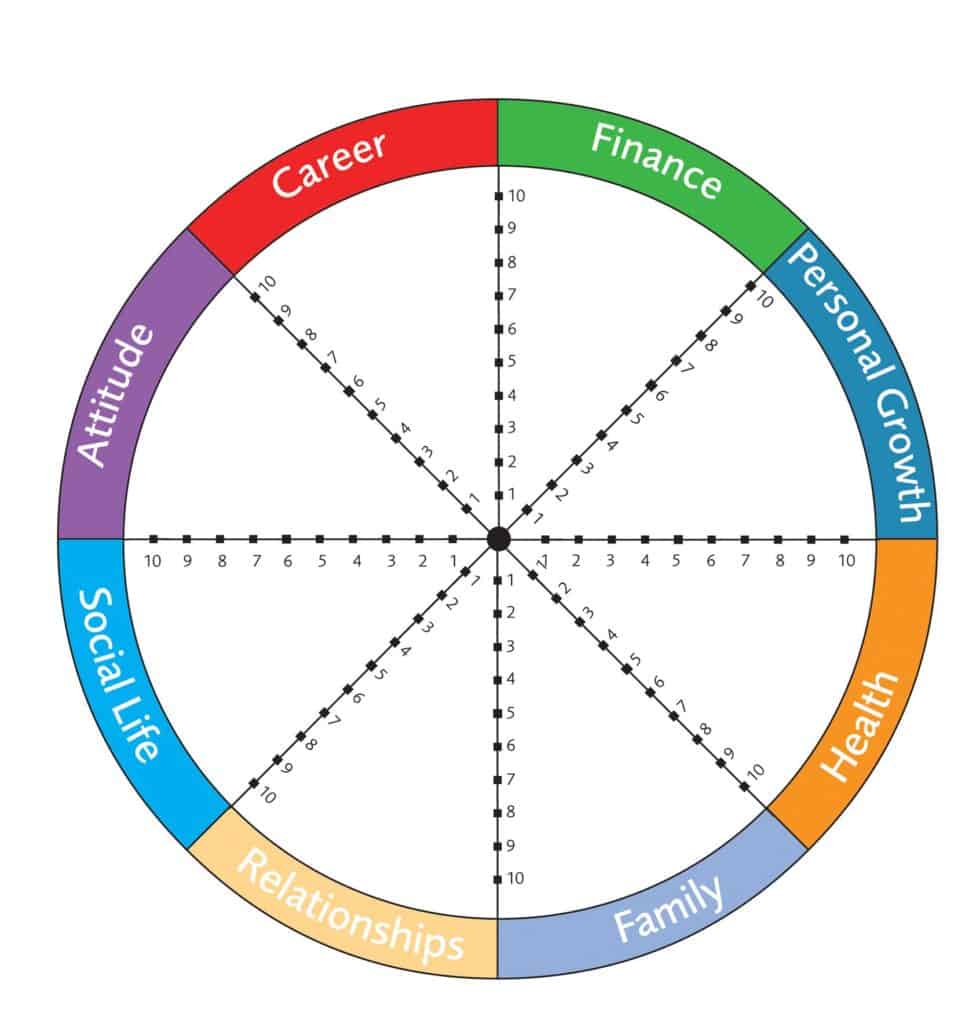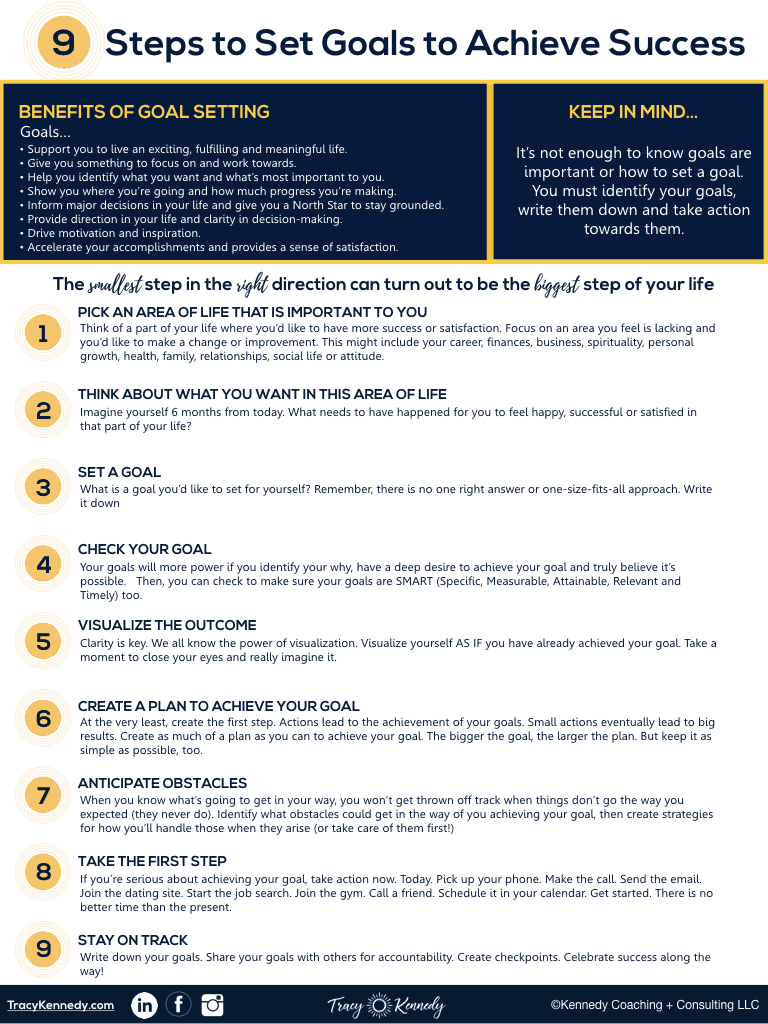 In fact, setting goals has many benefits….
In fact, setting goals has many benefits….
- They support you to live an exciting, fulfilling and meaningful life.
- They give you something to focus on and work towards.
- They help you identify what you want and what’s most important to you.
- They show you where you’re going and how much progress you’re making.
- They inform major decisions in your life and give you a North Star to stay grounded.
- They provide direction in your life and clarity in decision-making.
- They drive motivation and inspiration.
- They accelerate your accomplishments and provides a sense of satisfaction.
It’s not enough to know goals are important or how to set a goal. You must identify your own goals, write them down and take action towards them.As a corporate trainer, coach and consultant, I’ve learned that it doesn’t matter how much knowledge or information someone has. In order to take their learning to the next level, they must apply it. That’s where the real value comes in. So today, rather than give you more content, I’m going to walk you through a process. My goal? That you take the time to walk through this process yourself and when you finish this article, you’ll have at least one goal that supports you to live the life of your dreams. Here’s your step-by-step guide to setting and achieving a goal in life: Grab a pencil and paper, or open the notes on your phone and get ready to take action.
Step 1: Pick an Area of Your Life That Is Important to You.
Think of a part of your life where you’d like to have more success or greater satisfaction. Focus on an area you feel is lacking and you’d like to make a change or improvement. This might include your career, finances, business, spirituality, personal growth, health, family, relationships, social life or attitude. Check out the wheel of life below if you need some help. On a scale of 1-10, rate your current level of satisfaction in each area: The closer you are to the center-line, the more you lack in that area; the closer to the outer line, the more successful and happy you feel in that part of your life. Got an area you’d like to focus on? Great! You can move on to step two.
The closer you are to the center-line, the more you lack in that area; the closer to the outer line, the more successful and happy you feel in that part of your life. Got an area you’d like to focus on? Great! You can move on to step two.
Step 2: Think About What You Want in This Area of Your Life
If you don’t know what you want, how do you expect to get it?Imagine yourself 6 months from today. What needs to have happened for you to feel happy, successful or satisfied in that part of your life?Here are some ideas to get you started:
- Career - Do you want to get the raise or promotion, find a new role, take on a big project, improve your leadership skills, make a career switch or retire?
- Finances - Perhaps you want to have financial freedom, pay off debt, buy a house, make an investment or increase your income?
- Personal Growth - Do you want to improve your self-awareness, build confidence or self-esteem, address old wounds or heal trauma? Or do you want to learn a new skill, get an advanced degree or go back to school?
- Health - Do you want to have greater health and more energy? Perhaps you want to run a marathon, exercise more regularly, eat better, meditate or practice mindfulness.
- Relationships - Do you want to be in a loving relationship, be a better parent, be more compassionate, increase your social circle, spend more time with your friends?
Step 3: Set a Goal
There are all types of goals you can set for yourself.- Short-term goals, long-term goals, lifetime goals.
- Small, incremental goals and big hairy audacious goals (BHAG).
- Skill goals (to learn to ride a skateboard or peak a new language)
- Behavioral goals (to be more patient, kind or confident)
- Things you want to have (owning a house or car, making partner, finding a new job or career)
- Things you want to do (skydiving, spending time with family, exercising, losing weight or traveling to Australia)
- Experiences you want to enjoy (have you always wanted to skydive, run a marathon or take up painting?)
- What you want to give or how you want to contribute. (Think about your time, talents energy or money). Studies prove that those who give are happier, so if you want to be happier, make more goals to give.
Step 4: Check Your Goal
Make sure your goals are SMART (Specific, Measurable, Attainable, Relevant and Timely). You also must make sure you:- Identify your why: Why is your goal important to you? If you don’t know your why, you’re going to get distracted and lost along the way. Your goals must be meaningful and relevant.
- Have a deep desire to achieve your goal. The keywords here being YOU and DESIRE. You must really want to achieve this. It can’t be for someone else. Ask yourself, “Does this goal support the life I’m trying to create?”
- Believe it’s possible. You may not know how it’s going to happen, but in order to reach your goals, some part of you, deep down, needs to believe it’s possible. This is why it’s important to create goals that inspire and motivate you but aren’t so big that you don’t believe they’re possible.
Step 5: Visualize the Outcome
Clarity is key. We all know the power of visualization. Visualize yourself AS IF you have already achieved your goal. Take a moment to close your eyes and really imagine it. Step into that scene and feeling as much as possible. What do you notice? What do you see, hear or feel as a result of achieving this goal? Really put yourself in the power that you'll feel when you've achieved your goal. Next, it’s time to create a plan of action.Step 6: Create a Plan to Achieve your Goal
At the very least, create the first step. Actions lead to the achievement of your goals. Small actions eventually lead to big results. Create as much of a plan as you can to achieve your goal. The bigger the goal, the larger the plan. But keep it as simple as possible, too. Got your first step and a plan of action to achieve your goals? Great. You’re almost ready to get started. Before you do, you must identify your obstacles.Step 7: Anticipate Obstacles
When you know what’s going to get in the way, you’re going to be much less likely to get thrown off track when things don’t go the way you expected (they never do). What could get in the way of you achieving your goal? Consider factors such as distraction, procrastination, loss of focus, your environment, underestimating time and resources. For example, if you want to exercise three days a week, maybe you can foresee that work travel is going to get in the way. How can you make alternative plans for those weeks? Maybe you want to go back to school, but you’re not sure if you can get the financial aid you need. Sort that out first or figure out your plan. Read the top 7 reasons why so many New Year’s Resolutions (and goal-setting) fail here. Once you have a sense of what’s going to get in the way and have a strategy in place for when that arises, it’s time to get started.Step 8: Take the First Step
Remember that plan of action? What’s your first step? Take it.“A real decision is measured by the fact that you’ve taken new action. If there’s no action, you haven’t truly decided.” -Tony RobbinsIf you’re serious about achieving your goal, take action now. Today. Pick up your phone. Make the call. Send the email. Join the dating site. Start the job search. Join the gym. Call a friend. Schedule it in your calendar. Get started. There is no better time than the present.

Step 9: Stay on Track
In order to achieve your goals, you must stay on track. Think about a goal, resolution or commitment you made that you DID keep. What worked to keep you on track? Why did you keep it? What were the factors at play? In research conducted at the Dominican University of California, psychology professor Dr. Gail Matthews concluded the following:((Dominican University of California: Study Focuses on Strategies for Achieving Goals, Resolutions))“My study provides empirical evidence for the effectiveness of three coaching tools: accountability, commitment, and writing down one’s goals”Start by writing down your goals and placing them where you can see them. One statistic I read shared that 23% of people forgot their New Years' resolutions. Forgot! My sister tells the story often about the goal she had for selling her business. She wrote the sale price and date on a post-it and taped it to her mirror where she could see it daily. It served as a constant reminder of her North Star and what was most important to her. It kept her focused and on track. Our family goals are pinned to a bulletin board in the kitchen in our house for this very reason. Next, let’s talk about accountability.
Matthews found that more than 70 percent of the participants who sent weekly updates to a friend reported successful goal achievement (completely accomplished their goal or were more than halfway there), compared to 35 percent of those who kept their goals to themselves, without writing them down.Other studies have proven the same. Share your goals with others. Get an accountability partner to keep you on track or simply send weekly updates to a friend.((Thomas Oppong: This is How to Increase The Odds of Reaching Your Goals by 95%)) You can also create checkpoints. If you’ve ever participated in a long race, you know how important checkpoints are to keeping you on track. When you know where you are along the way to your goals, you can speed up, slow down or make changes. Lastly, always remember to celebrate your successes. Will you fail sometimes? Face setbacks or obstacles? Absolutely! But having a clear goal will get you further down the track. Create short term rewards for yourself and tie them to your checkpoints. For example, if you have a goal to lose 10 pounds by the end of the year, you might want to buy yourself a new pair of running shoes or treat yourself to a spa day when you’ve reached the half-way point.
Summing It Up

Bottom Line
Congratulations, you did it! If you followed the step-by-step instructions above, you now have a clear, compelling goal that will improve some area of your life. If you didn't go through the steps right now, you can schedule some time later today or this week to dedicate to this important process. I'm going to encourage you to schedule that now before you move on to the next thing! Then, it’s up to you to APPLY. Remember, knowledge is not power, action is.You are never too old to set another goal or to dream a new dream. -- C.S. LewisFinish this year strong and start the new year with clarity, focus, momentum and a sense of satisfaction knowing you’re one step closer to your goals.
More About Goal Setting
- How to Create an Action Plan and Achieve Your Personal Goals
- 14 Personal Goals for a Better You Next Year
- Having Trouble Reaching Goals? This Could Be Why
from Lifehack - Feed https://ift.tt/2YXpfqL
No comments:
Post a Comment